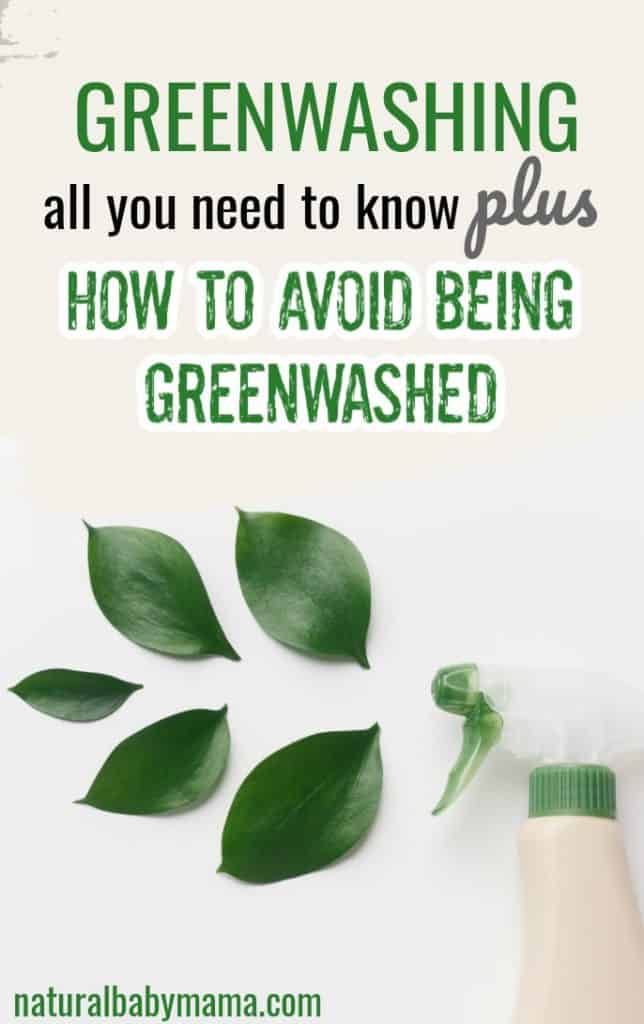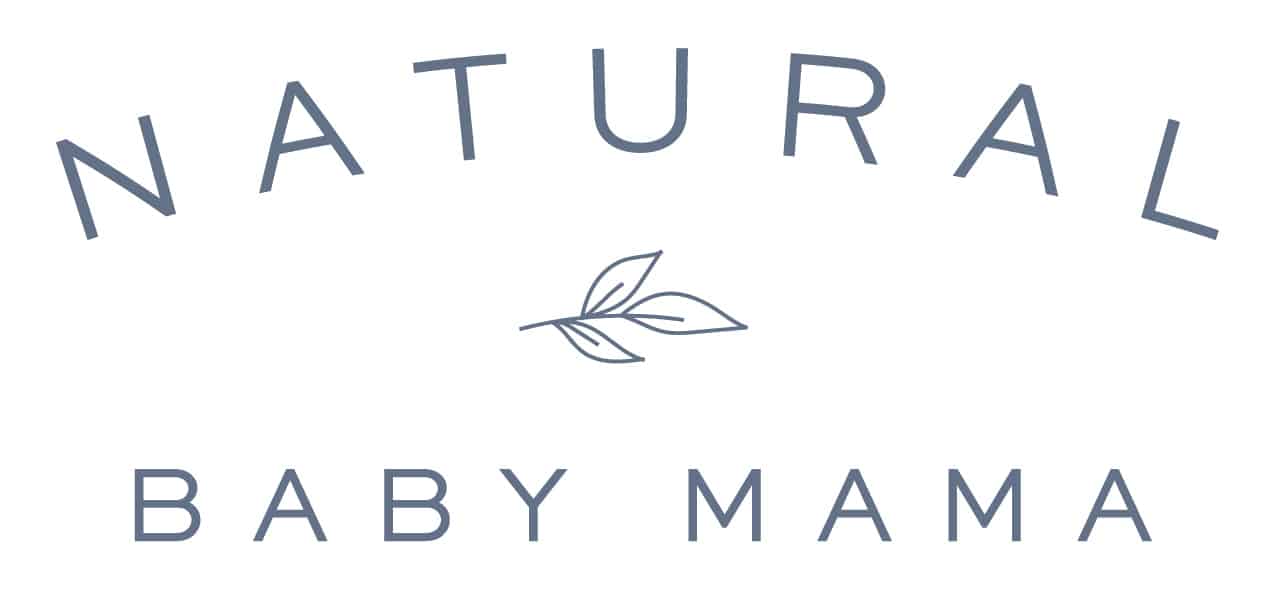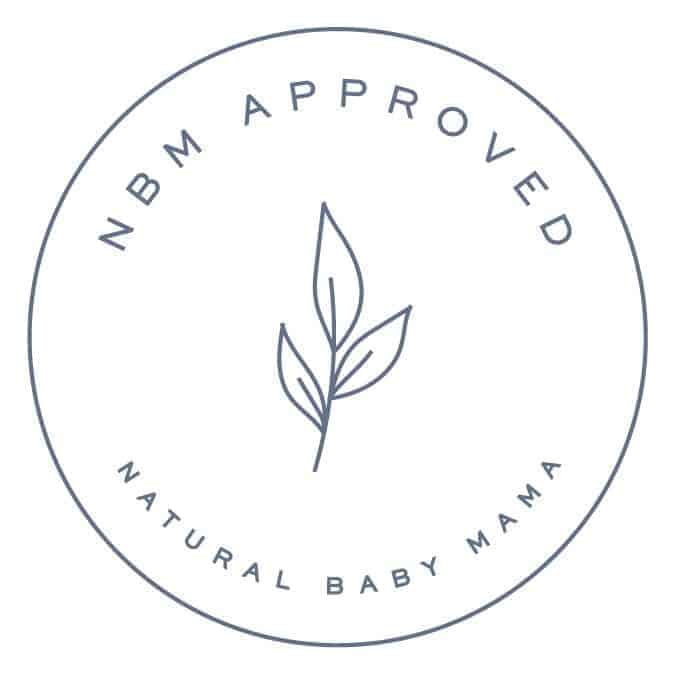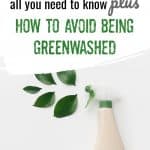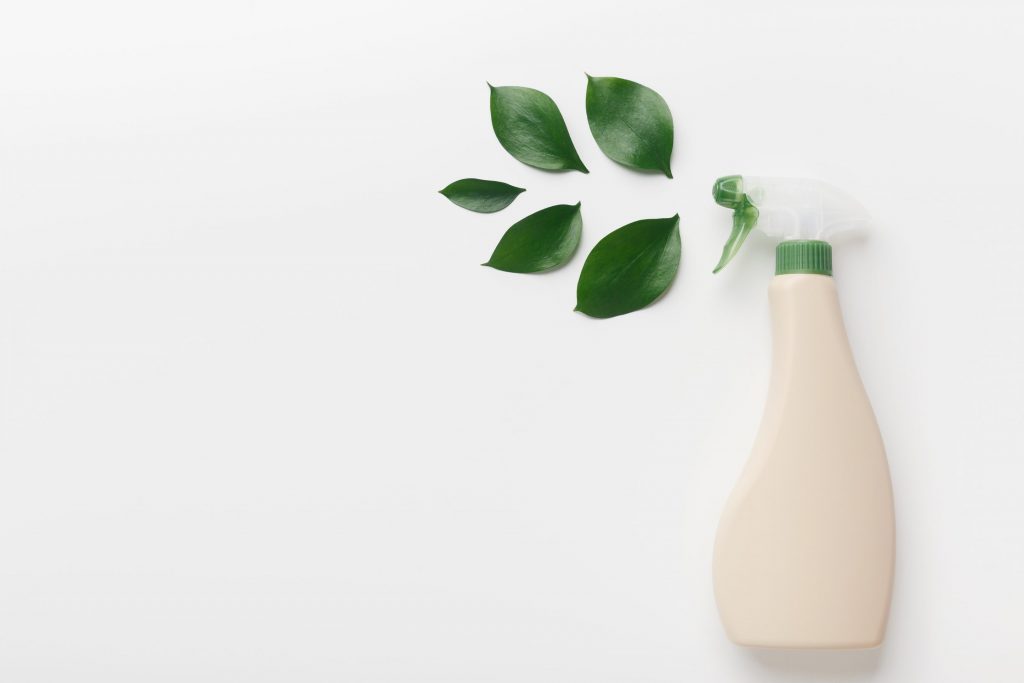
There has been an upswing in environmentally friendly products on the market in recent years. Many of us would choose a product that’s healthy for us and the environment. There are hundreds of labels with words like “eco,” “green,” “bio”, or “natural.” These terms sound tremendous and speak to our desire to purchase healthy products. However, many of these products are greenwashed. So, what is greenwashing and how can you avoid it?
This post may contain affiliate links. Please see my full disclosure policy for details.
Just because natural-sounding terms are present doesn’t mean they’re true. Companies have started placing buzz words like these on their products only to increase sales, not necessarily to keep your family or the planet healthy. This is called “Greenwashing”, and it has become increasingly popular in the marketing space over the past few years.
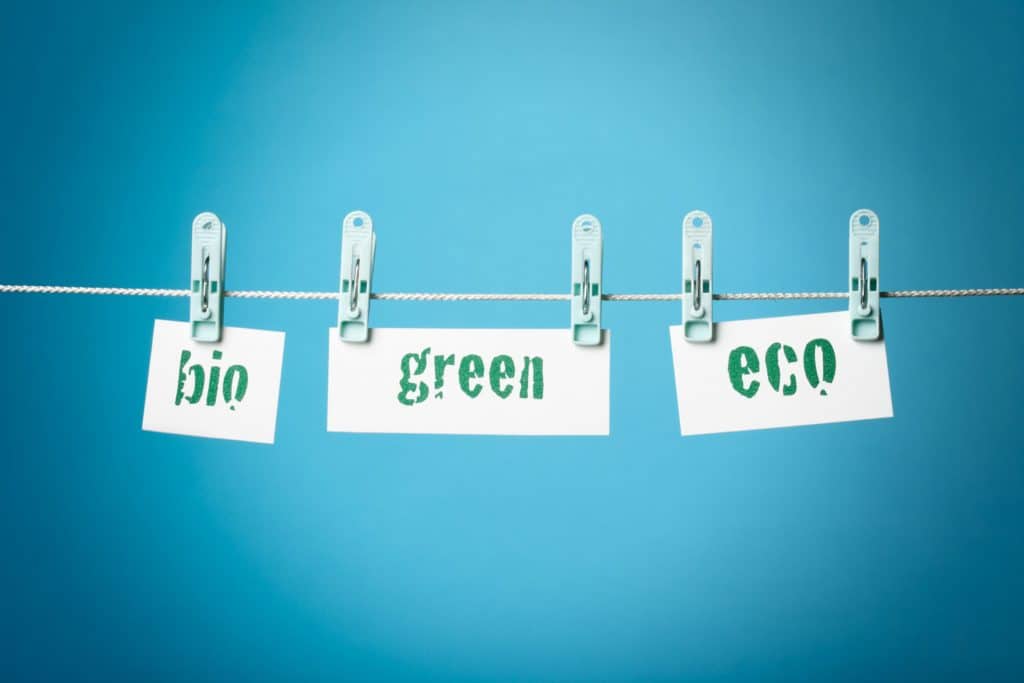
Quick Navigation
What is Greenwashing?
By now I’m sure you’re wondering what is greenwashing, and how do I avoid it?
Greenwashing happens when companies purposely mislead consumers to believe their products are healthy for the environment by using popular terms that speak to environmentally friendly values.
Companies can use words, phrases, or even images to make consumers think their products are safe for the planet. Unfortunately, many of these companies are still using harmful chemicals and substances that are terrible for you and the environment.
Greenwashed products can range from cleaning products, food, personal hygiene products, and even clothing. With the growing environmentally friendly trend, nothing is off the table for potential greenwashing.
But don’t worry. Not all companies are using superficial verbiage to sell unhealthy products. Some corporations are increasing their sustainability efforts while others are just pretending.
The key is learning how to identify the difference in a sea of grocery store isles where each product promises the world.
Why is Greenwashing an Issue?
Greenwashing is an issue for several reasons. First, brands try to trick consumers, by using deceptive marketing, into thinking products are healthy or natural when they actually aren’t.
Consumers believe companies are taking a stand to support sustainability when they’re actually not. Consumers will continue to support brands they believe are environmentally friendly, which in turn promotes poor brand habits and business practices.
The number one priority for businesses is brand perceptions. Brands will do whatever necessary to be perceived as ethical, even if that means including little white lies in their marketing efforts.
If consumers see a brand as unethical, they won’t buy from them, and their sales will go down. Then consumers will start looking to switch to ethical, healthy brands. Here is where greenwashing comes in.
Greenwashing companies are misleading consumers to think they are buying a natural, healthy, non-toxic product when their products still contain toxins that you were hoping to avoid or are not actually environmentally friendly.
If companies display their brands as healthy and all-natural, it’s a simple choice for the consumer, but all is not how it appears. The bottom line is that it’s cheaper for brands to implement eco-friendly marketing tactics than it is for them to be eco-friendly.
If you don’t look closely at the products you’re buying, you could easily get caught up on the pretty label instead of the ingredients. Now let’s talk about how to avoid Greenwashing.
How to Avoid Greenwashing
Telling the difference between a greenwashed product and a healthy product can be tough. Here are some things to look out for when avoiding greenwashed products.
Greenwashing Marketing Terms
Thousands of products on the shelf sport fancy terms like the ones below:
- Eco-friendly
- Non-toxic
- Biodegradable
- Recyclable
- Extract
- All-natural
- Organic
- Non-Toxic
- Plant-based
- Green
- Pure
- Gentle
- Sulfate-free
- Paraben-free
- Herbal
- Chemical-free
- Dermatologist recommended
- Oil-free
- Natural
These terms sound amazing, but is there any information on the packaging to back up these claims? There are little to no regulations to use these terms, so be skeptical if you see them on a product. This list isn’t comprehensive by any means, so look out for other words related to green-living or sustainability.
Also, it’s very important to know that some amazing, truly non-toxic products contain these words on their labels.
Bottom line: If you see these words advertised by a company, it doesn’t mean they are greenwashing and it also doesn’t mean they are truly non-toxic and environmentally friendly. Dig a little deeper to make sure they are backing up those claims with the ingredients they use.
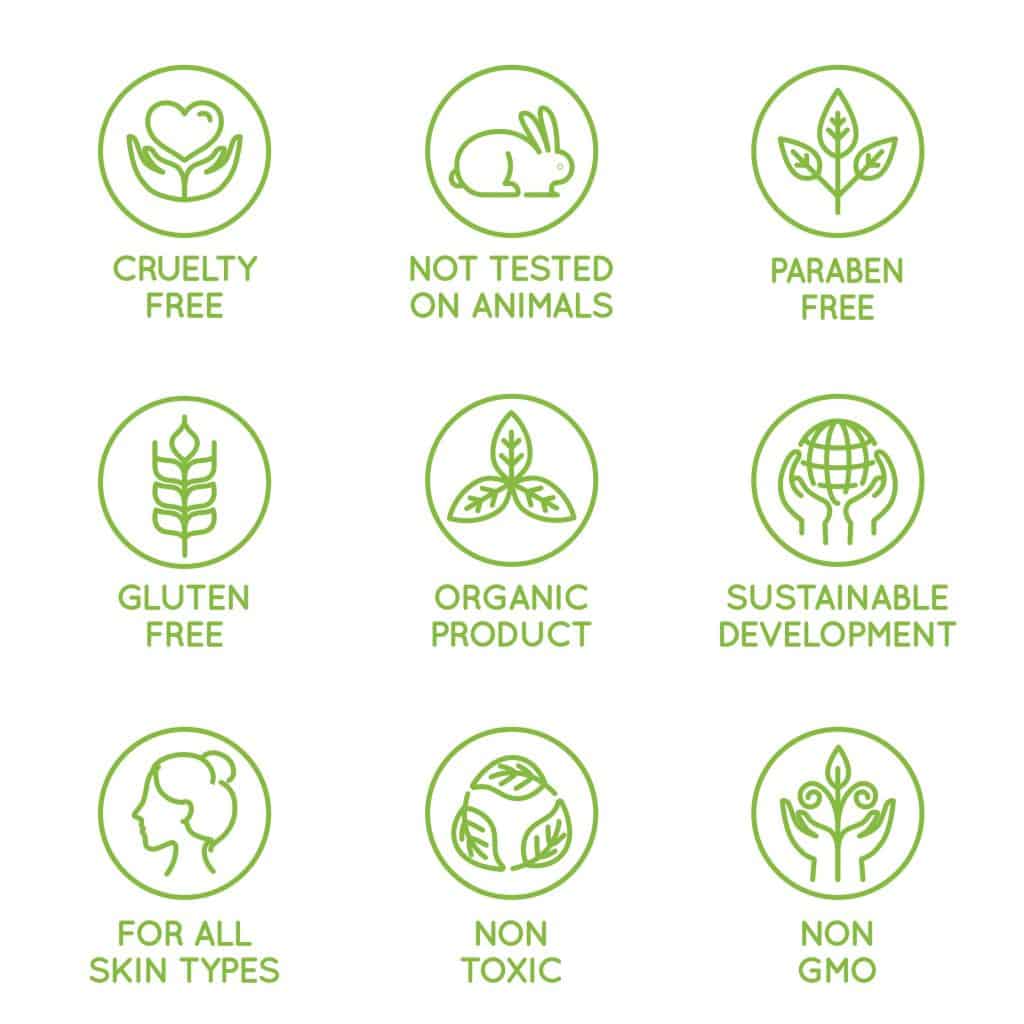
Natural or Green Looking Packaging
Too often, companies are creating packaging that portrays a natural product. You may see recycling symbols, cruelty-free stamps, happy grazing cows (or other smiling livestock), images of trees, leaves, or other natural pictures on the front of a product. These images and labels try and hook the consumer in hopes of distracting from the actual ingredients or origin of the product.
Personal care products might sport flowers, greenery, or use terms like “naturally derived,” “all-natural,” or “organic”. These images and terms are placed right on the front of the package to grab your attention and deter further investigation of the ingredients on the back.
Just because the product displays cruelty-free symbols with photos of happy livestock doesn’t mean it’s true. Many animal products that end up on our plates come from factory farms where animals are pumped full of antibiotics. Not only are factory farms horrible for the environment, but the food that comes from them is also horrific for our health.
Ingredient List to Avoid
These are a handful of ingredients you should avoid when purchasing healthy products.
- Behentrimonium Methosulfate
- Benzyl Alcohol
- Cocamidopropyl betaine
- Dimethicone
- Fragrance
- Alkylphenol ethoxylates (APEs)
- Ammonia
- Antibacterials & Disinfectants
- Butyl Cellosolve (also known as butyl glycol, ethylene glycol, monobutyl)
- Petroleum Solvents
- Chlorine bleach (sodium hypochlorite)
- Monoethanolamine (MEA) Diethanolamine (DEA) & triethanolamine (TEA).
- Glycol Ethers (ethylene glycol mono-butyl ether, EGBE or 2-Butoxyethanol)
- Triclosan
- Phthalates
- Phenols
- Phosphates
Again, this list is not comprehensive, and there are tons of synonyms that these harmful chemicals and ingredients can be named. For a more in-depth list, check out The MADE SAFE Hazard List of Chemicals, Materials & Ingredients. Or use resources like The Environmental Working Group to understand what you’re buying.
What Ingredients to Look For
So what ingredients should you look for when trying to avoid being greenwashed?
- USDA Certified Organic ingredients
- Organic or wildcrafted ingredients
- Non-GMO if not already certified organic
- Things you can pronounce!
Avoid Greenwashing by Reading Labels
The only way to know whether you’re buying a green product or not is to read the label. If you see green terminology listed on the front of the product, you can quickly tell if this is false by looking at the ingredient list.
The rule of thumb when it comes to ingredient lists is the shorter, the better. Also, can you pronounce the ingredients? Do you know what they are? Look for short, easily pronounceable ingredients for healthy non-toxic product choices.
Any brand under the sun can claim they’re healthy, but slapping a bunny or a green leaf on the front of the bottle doesn’t make it accurate. If there is no information to back up environmentally friendly claims on the packaging, you’ve picked up a greenwashed product.
Companies that use ethical business practices and sustainability will prove it on the packaging. Don’t rely on marketing to make you think something is safe. You can use the resources like EWG’s Skin Deep or use the Think Dirty App to help you navigate ingredients.
Examples of Greenwashing
Greenwashing is such a common practice that you probably don’t even realize it’s happening all around you. One example is deli’s and restaurants switching to pulp/biofriendly take-out containers from plastic. That sounds like a great move, but in reality, these takeout containers are lined with plastic and PFA’s, meaning they can’t be composted. In addition, PFA’s are forever chemicals. Meaning they stay in our environment forever. They are also very toxin for humans.
Another example of greenwashing is when Starbucks switched away from using plastic straws. However, they moved to new lids that contain more plastic than the straws did. While doing away with plastic straws was great, they did not reduce their environmental impact. Mcdonald’s has done something similar by switching to paper straws that can’t be recycled.
The same is true for bottled water companies like Evian, Deer Park, and Poland Springs. They use natural labeling for their products, but plastic water bottles are among the leading causes of pollution on the planet.
Even meat products can be greenwashed. Tyson chicken was recently exposed for using an all-natural label while giving their chickens large doses of antibiotics, feeding them genetically modified corn, and injecting them with salt water for a plumping effect.
The well-known brand Herbal Essences claims to provide an all organic experience, but the ingredient list reveals chemicals like lauryl sulfate, propylene glycol, and D&C red no. 33. Those are far from natural ingredients.
Clorox is another guilty company when it comes to greenwashing. They use green packaging for their Green Works Cleaning Wipes, claiming the wipes are biodegradable, which is true. But the plastic container they come in, along with the chemicals in the wipes are not biodegradable nor non-toxic.
These are only a few examples out of thousands of companies greenwashing products to fool the consumer.
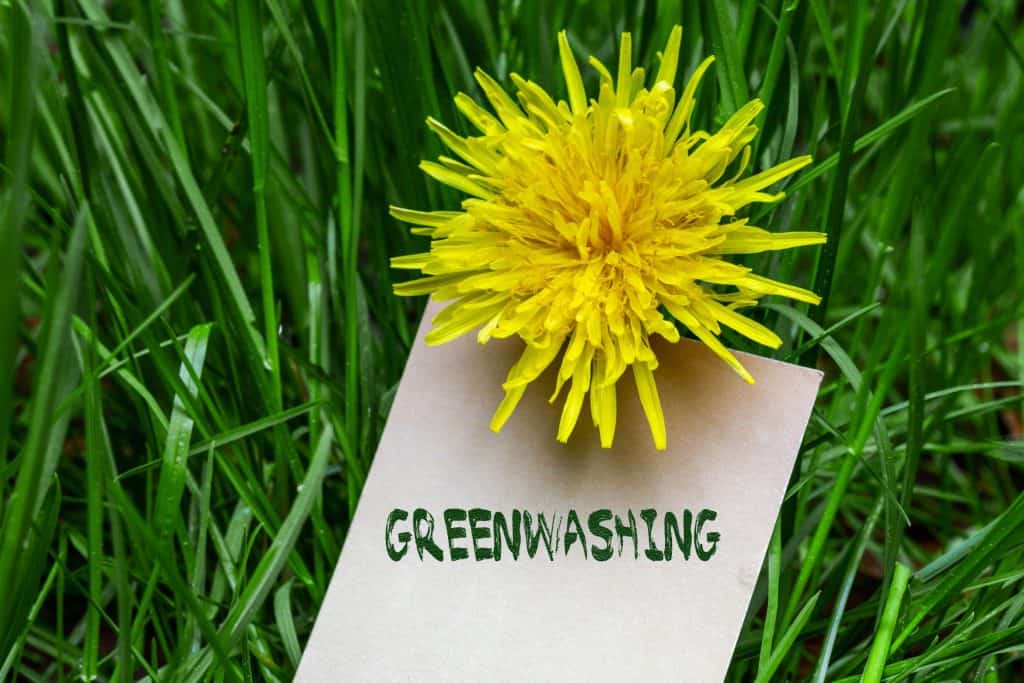
Greenwashed Brands to Watch Out For
Several brands display greenwashing so well they have become synonymous with eco-friendly products. Below is a list of these brands.
These companies are on this list due to the toxic ingredients present in their products or environmentally harmful business practices. Keep in mind, this list isn’t comprehensive, and you have the right to purchase these products if you choose to.
- Mrs. Meyers
- Babyganics
- Aveeno
- Seventh Generation
- Aveda
- Airborne
- Melaleuca
- Johnson’s Natural
- GreenPan
- Nestle
- Kauai Coffee
- Charmin
There are more companies guilty of greenwashing that isn’t on this list, many of them successfully getting away with fooling the consumer into thinking they are buying a healthy product. Like with most things, doing your research is vital to avoid greenwashing, which brings me to my next point.
Steps to Take to Avoid Being Greenwashed
Greenwashing is such a commonplace practice in today’s society you have to be diligent to stay ahead of the curve. The most important thing you can do to avoid greenwashing is to read the label!
You can tell whether a company is blowing smoke about their love for the environment by reading the ingredients in the product. Using resources like EWG’s Skin Deep or the Think Dirty App mentioned above can help you navigate tricky ingredients. It’s so simple to use both of these resources.
Next, only go with the ingredients you recognize and trust. Remember, the shorter the ingredients list, the better and ingredients that you understand. Don’t be afraid to google something you don’t understand.
Keep in mind that supporting greenwashed businesses encourages their bad habits and ultimately unhealthy practices for us and our planet.
Don’t fall for marketing terms and beautiful packaging. Anyone can slap an environmentally friendly logo on their product and call it a day. Remember, there is little to no regulation around these labels. Just because it’s paraben-free or a piece of the product is biodegradable doesn’t mean it isn’t filled with toxic chemicals.
Finally, do your research! You have all the information you need to distinguish a greenwashed product from an authentic product at your fingertips. Google will tell you everything you need to know about the complicated ingredients listed on the package! Using EWG’s Skin Deep and Think Dirty App makes it even easier!
I also have an Amazon Storefront full of vetted non-Greenwashed products – make sure you check it out!
You can also find safe brands for food, organic clothing for children, and non-toxic toys in my healthy living guides.
Final Thoughts
It’s cheaper for companies to center their marketing around environmentally friendly ideas than it is for them to be environmentally friendly. This leads brands to greenwash their products to trick consumers into thinking they’ve bought a healthy product when they haven’t.
Greenwashing can be avoided by looking past marketing and buzz words to the actual ingredients in the products you’re buying. The ingredient list will tell you whether the company is genuine or not. You can use resources like the Natural Baby Mama Amazon Storefront, EWG’s Skin Deep, Think Dirty App, and Google to research ingredients before purchasing.
When it comes to avoiding greenwashed products, question everything! It can be overwhelming to find truly safe products, I have created my Amazon Storefront for vetted non-toxic products that are not greenwashed.
Pin it for later!
